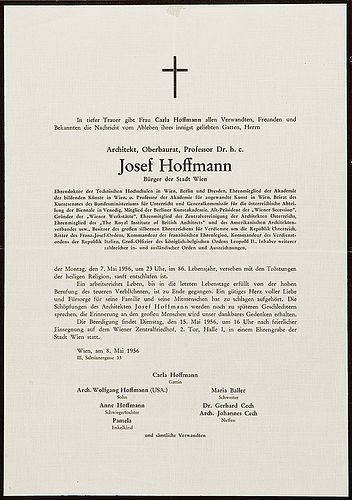Obituary Josef Hoffmann offset printing/paper, 29.8 x 21 cm
Lot 56
Estimate:
EUR€100 - EUR€200
$104.17 - $208.33
Absentee vs Live bid
Two ways to bid:
- Leave a max absentee bid and the platform will bid on your behalf up to your maximum bid during the live auction.
- Bid live during the auction and your bids will be submitted real-time to the auctioneer.
Bid Increments
| Price | Bid Increment |
|---|---|
| EUR€0 | EUR€10 |
| EUR€100 | EUR€50 |
| EUR€700 | EUR€100 |
| EUR€1,000 | EUR€200 |
| EUR€3,000 | EUR€300 |
| EUR€3,600 | EUR€400 |
| EUR€4,000 | EUR€500 |
| EUR€7,000 | EUR€1,000 |
| EUR€16,000 | EUR€2,000 |
| EUR€30,000 | EUR€3,000 |
| EUR€36,000 | EUR€4,000 |
| EUR€40,000 | EUR€5,000 |
| EUR€150,000 | EUR€10,000 |
About Auction
By Widder Auctions
Nov 28, 2022
Set Reminder
2022-11-28 10:00:00
2022-11-28 10:00:00
America/New_York
Bidsquare
Bidsquare : Viennese Art Nouveau, Expressionism, Modern Art
https://www.bidsquare.com/auctions/widder-auctions/viennese-art-nouveau-expressionism-modern-art-10414
Widder Auctions office@widderauktionen.com
Widder Auctions office@widderauktionen.com
- Lot Description
Obituary Josef Hoffmann
offset printing/paper, 29.8 x 21 cm
provenance: Carla Hoffmann, private collection Vienna
ESTIMATE #Euro 100 - 200
STARTING PRICE #Euro 100
Josef Hoffmann, a student of Carl Hasenauer and Otto Wagner and a founding member of the Vienna Secession, was one of the central figures of Viennese modernism as an architect and designer. Josef Hoffmann created residential buildings for Carl Moll, Koloman Moser, Eduard Ast, Otto Primavesi, Robert Primavesi and Sonja Knips, among others. In connection with the International Art Exhibition in Rome, for which Hoffmann built the Austrian pavilion, Anton Hanak introduced Hoffmann to the Primavesi family of bankers and industrialists, who were also friends of Gustav Klimt. For Robert Primavesi, Hoffmann built, among other things, the Skywa-Primavesi villa in Vienna-Hietzing, and for his cousin Otto Primavesi he furnished the town house in Olomouc, built a bank house there, and erected a country house in Winkelsdorf. In 1903 Hoffmann founded the Wiener Werkstaette (WW) with Koloman Moser and industrialist Fritz Waerndorfer, modeled on the British Arts and Crafts Movement and influenced by Viennese Art Nouveau. Otto, Eugenia and Robert Primavesi participated in the WW in 1914 with a contribution of 400000 crowns. Hoffmann remained one of the most important designers of WW until its bankruptcy in 1932. The Wiener Werkstaette aimed to unite the entire spheres of human life in design, in the sense of a Gesamtkunstwerk. Among the WW staff were about a dozen women who were crucial to the stylistic shift from Art Nouveau to Art Deco in the 1920s, such as Vally Wieselthier, Gudrun Baudisch, Reni Schaschl, Hilda Jesser, and Susi Singer. Together with Stefan Rath, the head of the glass manufacturer Lobmeyr, Josef Hoffmann founded the oesterreichischer Werkbund (oeWB) in 1912. Hoffmann designed numerous glasses and chandeliers for Lobmeyr during this period. Josef Hoffmann survived the Nazi era unscathed despite hostility from the Nazi architectural ideologist Paul Schmitthenner. He was commissioned by the Reich Chamber of Fine Arts to further develop the Vienna Arts and Crafts Association (a Nazi successor organization to the Austrian Werkbund) as its artistic director. To this end, an "artistic experimental institute" was founded in 1941, where young artisans could further their education under Hoffmann's guidance. After the war, in 1948, Hoffmann founded the oesterreichische Werkstaetten as the successor to the Wiener Werkstaette and oeWB. Hoffmann's tombstone was designed by Fritz Wotruba. Psrtezettel, signed by name by the surviving dependents Carla (Karla) Hoffmann, born Schmatz, Wofgang Hoffmann, Anne Hoffmann, Pamela, Gerhard Cech and Johannes Cech.
PLEASE NOTE:
The purchase price consists of the highest bid plus the buyer's premium, sales tax and, if applicable, the fee of artists resale rights. In the case of normal taxation (marked #), a premium of 24% is added to the highest bid. The mandatory sales tax of 13%, for photographys 20%, is added to the sum of the highest bid and the buyer's premium. The buyer's premium amounts to 28% in case of differential taxation. The sales tax is included in the differential taxation. - Shipping Info
-
We will send you the invoice shortly after the auction. As soon as we have recieved the amount, the art can be picked up at Johannesgasse 9-13, 1010 Vienna. Please note that the buyer is responsible for pick-up and shipping of the lot. Should you wish to ship your items, please contact: Mailboxes Email: oper@mbe-co.at Tel: 01 5128855 Please note that storage fees may apply, should the pieces not be picked up within 14 days after invoicing for domestic and 28 days for international transportation. Our team will be happy to assist you with any further information at office@widderauktionen.com or at 0043 676 555 66 10.
-
- Buyer's Premium



 EUR
EUR CAD
CAD AUD
AUD GBP
GBP MXN
MXN HKD
HKD CNY
CNY MYR
MYR SEK
SEK SGD
SGD CHF
CHF THB
THB











